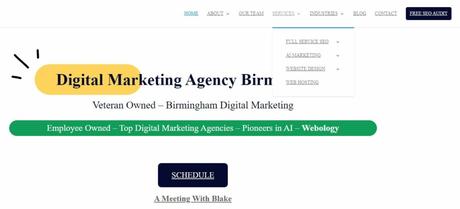If you’re scratching your head wondering why is my website not generating leads like it should, you’re not alone.
Most website owners struggle to convert visitors into leads.
The good news is there’s always a reason (or a few) behind your website’s inability to generate quality leads. More importantly, there’s always a solution.
Sometimes it’s something really simple like the clients who have came to us over the years with a ‘noindex’ tag on their website that tells search engines to ignore all their content.
Just turn off that setting in WordPress and you’re all done.

Other times, your site’s rating drops due to a more complex penalty we have to troubleshoot and fix. I’ve seen it all over the last 10 years working in the marketing industry.
So in this guide, we’ll talk about the most common lead generation mistakes I see and how you can fix them.
We’ll explore these issues step by step and for each one, we’ll look at practical solutions you can implement.
By the end, you’ll have a clear picture of where your site stands and how you can convert it into a lead generation machine.
Let’s get started.
Why is My Website Not Generating Leads (And, How to Fix It)
Here are the reasons why your website isn’t generating leads like this and what you should be doing about it.
You Have a Weak SEO Strategy

Your website’s search engine performance has a massive impact on its ability to generate leads.
See, effective SEO not only helps you attract quality search engine traffic, but also makes your site user-friendly.
Invest your resources into creating and implementing a well-rounded SEO strategy, which includes:
- Keyword research
- Technical SEO (Helps with crawling and indexing)
- Quality content with on-page SEO
- Active link-building
Consider publishing high-quality blog posts to showcase your expertise. This will help you build authority on the topic, potentially boosting your site’s organic positions in search engines.
Your Web Pages Are Slow 

Slow-loading web pages are user-experience killers. Long wait times will send the majority of your visitors away.
People want to get the answer to their query quickly, so your website should load within 3 seconds.
You can check its speed with a free online tool like Google PageSpeed Insights or Pingdom.
They will offer suggestions to help you make it faster.

Here are some tips on making a website load swiftly.
- Compress your images
- Minify and compress CSS and JavaScript
- Leverage browser caching
- Reduce server response time
- Minimize HTTP requests
- Use asynchronous loading for JavaScript
- Optimize web fonts
- Minimize redirects
- Implement AMP (Accelerated Mobile Pages) for mobile
- Use a content delivery network (CDN)
- Remove unused code
- Optimize third-party scripts
Your Web Form Isn’t Converting
Your web form is a crucial touchpoint for lead generation. Here are some common reasons why it might not be working:
- Complex design
- Too many fields
- Lack of mobile optimization
- Unclear value proposition
Optimize the lead generation form on your website by:
- Asking for only necessary information
- Keeping it simple
- Clearly communicating the benefit of filling out the form (E.g., a lead magnet)
Also, make sure your form loads and functions correctly on mobile phones.
Here’s an example:

Your CTAs Aren’t Good Enough
A website without CTAs is like a shop without a checkout counter – visitors may browse, but they won’t convert into leads.
But, simply having them isn’t enough. Your CTAs need to be visible and strategically placed throughout your content.
Your Content Isn’t Good Enough 

The importance of high-quality content in lead generation can’t be overstated.
Plus, it should resonate with your audience and address their pain points.
Make sure to create content that educates your users while subtly promoting your services.
When your website offers valuable, informative, and engaging content, users are more likely to stay on it.
This improves your chances of converting them into leads.
You’re Not Getting Enough Visitors
Keyword research is the key to successful lead generation through blog posting.
You want to work on keywords that are low-competition and have decent monthly search volumes.
Also, note that more traffic doesn’t always mean more leads. You need to implement CRO (Conversion rate optimization) best practices to turn prospects into leads.
You May Also Like: Maximize Website Performance: Boost Speed and SEO
Your Site’s Navigation Isn’t Optimized
Your site’s navigation plays a crucial role in lead generation. It guides visitors from the initial point of contact to the last point where conversion happens.
A well-structured, user-friendly navigation helps visitors find what they came for, whether it’s product information, contact form, or pricing details.
Plus, when visitors can easily explore your site, they spend more time on it, improving their chances of becoming a lead.
Poor site navigation can be a major problem, causing users to leave before they have the chance to convert.
First, you need to ensure that the home page of the site is well-designed and directs visitors effortlessly to the most crucial pages.

These pages should be designed to capture leads with a dedicated lead capture form.
A significant aspect of optimizing navigation for lead generation is creating a logical hierarchy that guides visitors through the website.
Ensure that primary navigation elements include essential sections like products, services, about us, and contact pages.
The design should incorporate dropdown menus that offer easy access to secondary pages.
Lastly, regularly reviewing and updating your site navigation based on user behavior analytics can help refine and enhance its effectiveness over time.
Here’s a quick overview of the factors involved in making or breaking your lead generation efforts.
- Craft Clear Headlines: Ensure your headlines are captivating and clearly convey the value or benefit to your audience.
- High-Quality Visuals: Use high-resolution images, videos, and graphics that are relevant and engaging.
- Relevant Content: Provide content that addresses the needs, questions, and concerns of your target audience.
- Concise and Scannable Text: Write in short paragraphs and use bullet points to make the content easily scannable.
- Incorporate Strong CTAs: Use clear and compelling calls-to-action to guide users toward desired actions.
- SEO Optimization: Utilize keyword research to optimize your content for search engines, improving visibility.
- Unique Value Proposition: Clearly communicate what sets your product or service apart from competitors.
- User-Friendly Language: Avoid jargon and use simple, straightforward language that your audience can understand.
- Social Proof: Include testimonials, reviews, and case studies to build trust and credibility.
- Loading Speed: Optimize images and reduce other media sizes to ensure fast page loading times.
- Readable Typography: Choose fonts and font sizes that are easy to read on all devices.
- Mobile Optimization: Ensure that your website is fully responsive and functions seamlessly on mobile devices.
- Internal Linking: Use internal links to guide users to related content and improve site navigation.
- Data-Driven Insights: Use analytics to understand user behavior and refine your content strategy accordingly.
- Engaging Headlines and Subheadings: Create engaging and informative headlines and subheadings to keep readers interested.
- Interactive Elements: Incorporate quizzes, polls, and other interactive elements to engage users.
- Contact Information: Make it easy for visitors to find your contact information and reach out.
- Trust Badges: Use security and trust badges to reassure users about the safety of their data and transactions.
- A/B Testing: Continuously run A/B tests to determine what content and design elements perform best.
- Storytelling: Use storytelling techniques to make content more relatable and memorable.
- Accessibility: Ensure content is accessible to people with disabilities by following accessibility guidelines.
- Professional Editing: Have your content reviewed by professional editors to ensure clarity, grammar, and overall quality.
And, here’s how’s how you can maximize your conversion rates on each web page of your website:
Table: Website hierarchy with 9 CRO best practices.
1 Homepage
- Clear value proposition
- Strong CTAs (Call to Actions)
- Simple navigation
- Trust signals (testimonials, awards)
2 Category Page
- Filter and sort options
- Descriptive category headings
- Relevant imagery
3 Product Page
- High-quality images
- Detailed product descriptions
- Customer reviews
- Strong CTAs
- Trust signals (guarantees, return policies)
4 Landing Page
- Focused message
- Minimal distractions
- Compelling headlines
- CTAs above the fold
- A/B testing elements
5 About Us Page
- Company story and mission
- Employee bios
- Contact information
- Trust signals (accreditations, press coverage)
6 Contact Us Page
- Simple contact form
- Multiple contact methods (email, phone, social media)
- Map and directions
7 Blog Page
- Engaging headlines
- Share buttons
- Email subscription forms
- Relevant CTAs
- Author bios and credibility
8 FAQ Page
- Clear and concise answers
- Search functionality
- Link to relevant products/pages
9 Testimonials/Reviews Page
- Authentic customer feedback
- Multimedia testimonials (video, text, images)
- Trust signals (author details, dates)
Why Is My Website Not Generating Leads: FAQs 

Let’s address some frequently asked questions about converting visitors into prospects or leads.
Q: Why isn’t my website generating leads?
A: Several mistakes could be preventing your website from generating leads. Key issues include a lack of search engine optimization (SEO) & CRO, no or ineffective calls to action (CTAs), poor site navigation, and slow loading speeds.
Q: How important is Search Engine Optimization (SEO) for lead generation?
A: SEO is critical for lead generation because it improves your website’s ranking on search engine results pages, making it easier for potential customers to find your site. Higher visibility increases the chances of attracting and converting leads.
Q: What role do Calls to Action (CTAs) play in generating leads?
A: CTAs are essential in guiding visitors to take steps that lead to conversion, such as subscribing to a newsletter, filling out a form, or making a purchase. Without visible and strategically placed CTAs, you’ll have a tough time converting visitors into leads.
Q: How does site navigation affect my website’s ability to generate leads?
A: Effective site navigation ensures that visitors can easily find the information they need, enhancing their overall experience. Poor navigation can cause users to leave your site without converting. A clear and intuitive navigation structure is crucial for guiding users through the lead funnel.
Q: What impact does page speed have on lead generation?
A: Page speed is vital as slow-loading pages can frustrate users and cause them to leave your site. Ensuring fast page load times creates a better user experience, which is crucial for keeping potential leads engaged and increasing conversion rates.
Q: How can content quality and relevance improve lead generation?
A: High-quality, relevant content that addresses your audience’s pain points can significantly boost lead generation. Engaging and informative content builds trust and encourages visitors to engage with your brand, making it easier to convert them into leads.
Q: What makes a landing page effective for capturing leads?
A: A well-designed landing page should be user-friendly, mobile-responsive, and include relevant information that offers value to your audience. Clear CTAs and lead capture forms are essential elements that make a landing page effective for lead generation.
Q: Can using a website builder help improve my lead generation efforts?
A: Yes, using a website builder can help with lead generation by providing tools for creating well-optimized, user-friendly web pages. Features like built-in SEO tools, easy integration of CTAs, and streamlined site navigation can significantly boost your ability to attract and convert leads.
Blake’s Final Thoughts on Website Lead Gen 

If your website is not generating leads, there are a few things you can do. Effective lead generation starts with creating a seamless user experience for visitors.
Put yourself in your visitor’s shoes and see if your website is offering a smooth user experience.
Start by checking your site’s navigation. A cluttered, confusing layout can be a major turnoff. Simplify the path visitors take to find crucial information and contact forms.
Plus, mobile optimization is non-negotiable. A website that’s not mobile-friendly can deter a lot of potential leads, as most of the web traffic comes from mobile devices.
Another critical aspect is your content. Offering valuable, high-quality content builds your authority and engages visitors, increasing your lead generation results. Additionally, content that’s optimized for all the right on-page SEO factors can improve your organic rankings, driving more traffic.
Moreover, actionable calls-to-action (CTAs) scattered throughout the site can also significantly improve your lead generation results. Keep them simple, short, and clear.
Lastly, utilize analytics to monitor your site’s performance. Identifying which pages have high bounce rates helps pinpoint where improvements are needed, ensuring you’re not repelling leads.
